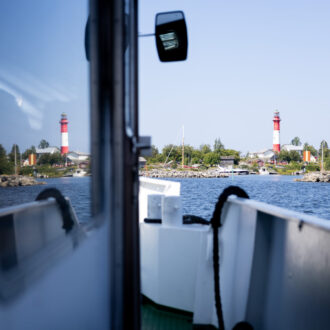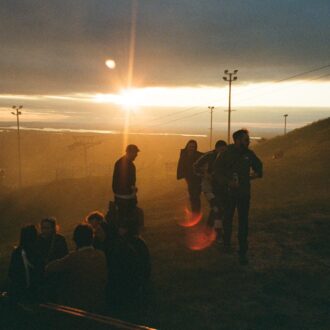On June 6, 2004, the whole world — tout le monde, as the French would say — watched entranced as the landing of American and British soldiers on the shores of Normandy amidst a hail of German bullets was relived on TV.
Presidents Bush, Chirac and Putin and Prime Minister Blair joined in celebrating that heroic opening of a huge effort that culminated 11 months later in the defeat of Germany — or the liberation of Germany, as Chancellor Schröder put it.
But where was the Red Army? After all, Stalin had promised President Roosevelt and Prime Minister Churchill that the Soviet Union would mount a massed attack immediately after the Normandy landings. Three days later, on June 9, the Red Army did launch an attack, but not towards Berlin; instead, it was aimed at Viipuri through a sector 15 km wide on the western shore of the Karelian Isthmus.
This operation was no sideshow. The artillery bombardment, the prelude to the main offensive, was so massive that it was heard all the way to Helsinki. There were 300 to 400 artillery pieces per kilometre of front line in the attack sector, and the vanguard of the attack force outnumbered the Finnish front-line forces on the Karelian Isthmus by two to one. Over 600 tanks were mobilized, and air support was provided by some 1,000 aircraft.
This offensive was an unexpected devastating blow that punched a hole in the Isthmus front and caused widespread panic. Even though intelligence on the appearance of new Soviet divisions and artillery and armoured units on the Isthmus had trickled through to Army Headquarters in Mikkeli, the Finnish High Command failed to conclude that this was in preparation for an attack on Finland. The received wisdom was that the Soviet troops were bivouacked, recuperating in preparation for a massive push towards Germany. It was thus, as Mannerheim put it, “Strange, to say the least, that the Russians should attack us”.
In the West, the outlook was much the same. Defeating and occupying Germany was an objective that took precedence over all others. It was considered self-evident that as the Allies advanced towards Germany, the countries occupied by the Germans would be liberated. That was, after all, what the war was all about.
Finland’s separate position
The Soviet command — or shall we say Stalin — had a different conception. While bringing Germany to its knees was of course Stalin’s main objective too, he was also determined to ensure that his neighbours allied with or occupied by Germany would come under the sphere of influence of the Soviet Union, constituting a ‘buffer zone’. Once the Red Army had expelled German forces from the Baltic States, Poland, Hungary, Romania and Bulgaria, these countries could be brought under Soviet control on the sly. Finland, however, did not lie on the direct route to Berlin. It was on the sidelines, and beyond it lay a neutral state, Sweden.
Finland considered itself a case apart from all other countries at war. We considered that we were fighting a separate war against the Soviet Union, a war justified by Finland being the victim of aggression in the Winter War of 1939-40. The morally acceptable purpose of the Continuation War, which began in 1941, was to seek retribution for the wrongs that Finland had suffered. This separate war was to lead to a separate peace which would restore the territories that Finland had lost in the Winter War.
A separate peace with Finland was discussed at the summit meeting of the three major powers in Teheran on December 1, 1943. Roosevelt spoke in favour of Finland, and so did Churchill, even though Britain had declared war on Finland in December 1941. Stalin admitted that “a people that had fought so valiantly for its independence deserves consideration”. He presented his terms for peace: restoration of the borders of the 1940 treaty; annexing Petsamo to the Soviet Union; a “50 per cent restitution” for the damage caused by the Finns; the expulsion of Germans from Finland; and demobilization of the army. Roosevelt and Churchill did not comment. For them, the important thing was for Finland to remain an independent and democratic society.
Finland’s political leadership had realized as early as the winter of 1942-43, around the time of the Battle of Stalingrad, that Germany would lose the war and that Finland would have to get out of it as soon as possible. The Government headed by Edwin Linkomies was dubbed the ‘peace cabinet’. National Romantic aspirations of annexing Eastern Karelia and its Finnic peoples to Finland were quietly dropped. Paasikivi conveniently forgot the radio speech he had written in October 1941 where, quoting Dostoevsky, he surmised that Leningrad, the “window on Europe” opened by Tsar Peter the Great, would close as the Germans occupied it and that Russia’s political focus would shift towards the east and south, further from Europe. And no one brought up the fact that, in July 1941, Mannerheim had sworn that his sword would never be sheathed until Viena and Aunus (as the Northern and the Southern part of Russion Carelia were respectively called in Finnish) were free…
But when Paasikivi returned from Moscow with Molotov’s peace terms in March 1944, the Government and the majority of Parliament were aghast. The terms were considered draconian. However, the true reason for this was never spoken aloud. It was feared that Germany would punish Finland as it had only recently punished Hungary. German forces still held the whole of continental Europe. There were 200,000 German alpine troops in northern Finland, and the south side of the Gulf of Finland was under German control. The Germans could easily have “driven a wedge between the supporters of the Government’s peace policy and the people who vehemently opposed it”, wrote Linkomies in his memoir, Vaikea aika (A difficult time).
But Paasikivi’s position, whereby Finland should accept the Soviet terms despite their severity, found support among the opposition in Parliament. It became a political watershed used after the war to divide politicians into supporters of the ‘right’ and ‘wrong’ foreign policy.
Trapped between two superpowers
Instead of German punishment, Finland met with Soviet punishment. What was the true objective of the Red Army offensive? Was it to occupy Finland or merely lend weight to Molotov’s terms? The answer was to depend on the outcome of the campaign.
The defence forces on the Isthmus recovered from the unexpected crushing blow. No more than one week after the beginning of the attack, Mannerheim exclaimed with relief: “The Finns are fighting again!” Most of the soldiers who had fled in panic were sent back to the front (although 46 court-martialled deserters were executed, and 11 were shot without trial). On June 16, transfer of troops from Eastern Karelia to the Isthmus front was begun. The defences were strengthened, but the attack did not yet grind to a halt, and on June 20 Soviet forces captured Viipuri.
As the battle escalated, the political climate was heating up too. It is difficult for us in the age of the Internet to understand the morass of unclear and conflicting messages and rumours in which the ministers and generals and their aides became embroiled.
Suddenly, on June 22, the German Foreign Minister Joachim von Ribbentrop arrived in Helsinki, uninvited and unannounced, to demand that Finland commit itself unequivocally to Germany’s side. On the very next day, a message from Moscow came via Stockholm — a demand for surrender!
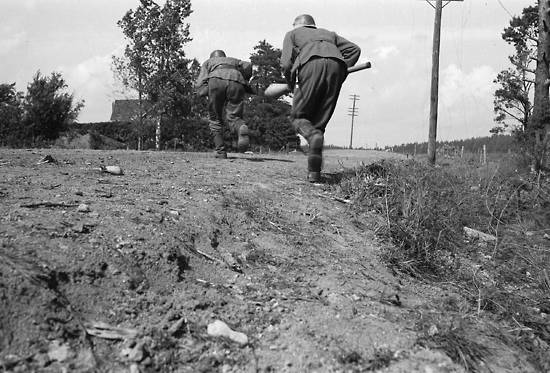
Finnish troops under fire cross a road in Ihantala.Photo: SA-kuva
Finland was now caught in a vice between two superpowers. Surrender, it was feared, would lead to Soviet occupation, while commitment to Germany to the bitter end would spell utter disaster. Now panic broke loose in political circles.
President Risto Ryti and Finance Minister Väinö Tanner tended towards surrender, while Mannerheim and Prime Minister Linkomies considered Germany’s military aid essential in repelling the Red Army offensive. The Government was split, although the majority of MPs favoured surrender. The only solution was for the President to take a personal stand. This was executed as a brilliant diversion.
Ryti sent a letter to Hitler, stating that he committed himself to continuing the war on Germany’s side to the very end. What he did not tell Hitler was that he would resign as soon as the situation demanded, at which point Finland’s commitment to Germany would be rendered null and void.
Hitler swallowed the bluff, considering the word of Finland’s “leader” a sufficient guarantee. So did the U.S. Government, who expelled the Finnish ambassador. So did the Swedes, who declared that Finland was now irrevocably doomed. So did the peace-favouring opposition in Finland — Paasikivi, Kekkonen, Wuori and Fagerholm — who began to set up a refugee government in Stockholm.
Stalin, however, appears to have called the bluff. This is the only explanation for why the Soviet ambassador in Stockholm, Madame Kollontay, sent the would-be refugee government back home, informing them that the Soviet Union would be talking terms of peace with the Finnish Government.
The political leaders of Finland, like many other leaders over the centuries, had taken a page from Machiavelli:
“…it did not appear he should avoid any procedure in order to save the country, for as the life of Rome depended on the life of that army, it appeared to him it should be saved in whatever way, and that the country is well defended in whatever way it is defended, either with ignominy or with glory; for by saving that army, Rome would in time wipe out that ignominy; but by not saving it, even though they should die most gloriously, Rome and its liberty would be lost.”
Ryti sacrificed himself in taking upon himself the “ignominy” to which the Western world considered Finland had stooped in relying on Hitler’s Germany to halt the Soviet offensive.
Hitler’s gamble
It has afterwards been observed that the bulk of the German aid had already been received before the Ribbentrop agreement. Panzerfaust and Panzerschreck anti-tank weapons had been ferried from Germany in April, Battle Unit Kuhlmey with its 70 aircraft had begun its campaign on June 17, and the first units of a German infantry division were on their way to Finland through Estonia before Ryti ever sent his letter to Hitler.
This division is considered to have played a major part in the defensive engagements at the Bay of Viipuri in July, while the assault gun brigade sent by the Germans had a negligible effect. The most spectacular contribution was made by the Stuka dive-bombers of Battle Unit Kuhlmey. In the battle of Tali-Ihantala, for instance, the German aircraft accounted for 63% of the bombs dropped on Soviet positions. Kuhlmey also shot down 151 Soviet aircraft. If no agreement with Germany had been entered into, Battle Unit Kuhlmey would probably have been withdrawn from Finland, and the infantry division would also have been recalled.
However, calling on Germany for help must be understood in a wider context. At Midsummer 1944, no one could possibly have known when and how the Soviet offensive might be halted. Continued help from Germany was considered vital. And continued it was; between the end of June and the beginning of September, Germany supplied Finland with a total of 28,860 tonnes of materiel, more than in any previous war year apart from the very beginning of the Continuation War.
But regardless of the quantity or nature of this military aid, what really decided Finland’s fate was Hitler’s great gamble, which shook the whole of Europe. In August-September 1939, Hitler turned his back on the east, and as a consequence the Soviet Union attacked Finland with intent to occupy; twelve months later, Hitler began to prepare his assault on the Soviet Union, and as a consequence Finland sought to regain the territories lost in the Winter War. At that point, “the whole world” believed that Germany would occupy the Soviet Union in a matter of months. If only we had known…
Defensive victories
Once the tables had been turned and the Soviet forces had the upper hand, no amount of German help could ever have saved Finland had not the patriotic fighting spirit of our forces continued to grow from strength to strength, notwithstanding the artillery bombardments, air raids and infantry and armour assaults of the Red Army, which surpassed anything previously seen. As the attention of the rest of Europe was focused on the advance of the Western Allies from the French coast to Germany, Finland’s struggle to remain independent went largely unnoticed, even in our neighbouring Sweden. The only thing that was remembered was that Finland had been on the wrong side. Finland was labelled as having fought “a losing war”.
When Prime Minister Göran Persson of Sweden visited Finland in summer 2002, his opposite number Paavo Lipponen took him to the Hämeenlinna Artillery Museum to watch a video on the battle of Tali-Ihantala. The half-hour documentary made a deep impression on Persson. He said on leaving the museum that only now did he realize what Sweden owed Finland.
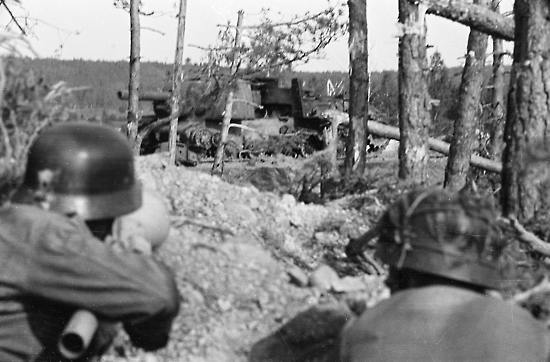
In the background, a Russian KV2 assault vehicle destroyed by Finnish anti-tank fire (foreground) at a crossroads between Ihantala and Karisalmi.Photo: SA-kuva
In addition to the defensive victory gained at Tali-Ihantala, the front line held fast at Kivisilta and Tienhaara to the north of the Bay of Viipuri and at Vuosalmi on the shores of the Vuoksi River. Further defensive victories were achieved at the Bay of Viipuri and on the northeast side of Lake Ladoga, and in Ilomantsi the Soviet contingent was besieged.
On July 12, the Soviet troops received an order to stop advancing and dig in. Soon Finnish scouts noticed trains with empty trucks advancing towards Viipuri to take troops away from the Finnish front. They were needed for the great push towards Berlin.
The defensive victory achieved by the Finnish Defence Forces showed once again that when a superpower, with its manifold objectives and commitments, is faced with a small nation fighting for its survival, the odds cannot be assessed simply on a one-on-one basis. For the second time in five years, Finland had succeeded in putting up such resistance that the price of occupying the country would have been so high as to damage other, more important interests of the Soviet Union; in 1940, continuing the war against Finland could have drawn the Soviet Union into a world war from which it had decided to abstain; and in summer 1944, the Soviet divisions in Finland were getting sidetracked from the decisive battles in the main theatre of war.
The ignominy of the alliance with Germany was expunged when Ryti resigned and Field Marshal Mannerheim was elected President on August 5. At that moment, the Army was still capable of defence, numbering 528,000 men. There were not enough Soviet forces on the Finnish front for a renewed assault. The Marshal-cum-President could calmly wait for the right moment to sue for peace. Daily he inspected intelligence reports on troop movements to the south of the Gulf of Finland to make sure that Germany would no longer be capable of retaliatory action against Finland.
The way to peace
Mannerheim’s initiative was patiently awaited in Moscow. Obviously Stalin trusted the Marshal; more than six months earlier, he had declared to the Swedish Foreign Minister that Mannerheim would not be touched.
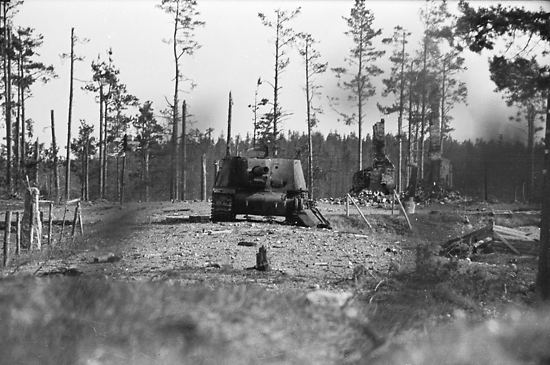
A Russian tank in position in front of a burned-out rural post office (background).Photo: SA-kuva
Meanwhile, negotiations on the terms of peace to be presented to Finland were still going on in Moscow. On July 21, Marshal Kliment Voroshilov proposed to Stalin that the Finnish border be pushed back west, so as to bring the Kaukopää mills belonging to Enso in Imatra and the Kaukas mills in Lauritsala to the Soviet side. This would have resulted in an extra refugee population of 250,000. Voroshilov further proposed that the Soviet Union should establish military bases in both Porkkala and Hanko and that Soviet troops should occupy Helsinki, Åland, Turku, Vaasa, Oulu and Tornio until the war against Germany was over. He proposed the sum of 800 million dollars in war reparations. Stalin, however, dismissed Voroshilov’s proposals.
No one in Finland knew anything about this, of course; it was not until the Soviet Union collapsed that Russian archives have become available to scholars.
The archives have yielded a more extensive version than previously known of the draft treaty presented by Molotov to Paasikivi in March 1944. It contained several demands that Paasikivi was never informed of, for instance the ceding of several naval bases to the Soviet Union and the ‘rectification’ of the border of 1940 so that the Saimaa Canal, the upper reaches of the Vuoksi River and the shore of Lake Saimaa would come under Soviet control. But Stalin ignored this too.
Finally, on August 24, Mannerheim sent Hitler a letter declaring that Finland was withdrawing from the war. Germany is such a mighty nation, Mannerheim wrote, that it shall live on even if it loses the war. Finland, however, is such a small nation that it could be evicted from its dwelling place and destroyed.
He could well have quoted J.V. Snellman, who wrote: “Only uncivilized tribes have been observed to fight unto their very destruction.” This, indeed, is what Hitler did.
Hostilities at the front ended on September 5, and negotiations on the truce agreement began. The terms of peace presented to the Finnish delegation included the ones that Stalin had presented to Roosevelt and Churchill in Teheran: the 1940 border, the annexation of Petsamo, the expulsion of German troops and demobilization. But there was a further condition that had not been mentioned in Teheran, the leasing of the Porkkala naval base to the Soviet Union.
The war lost
“Why was Finland never occupied?” asked Yugoslavian dictator Tito in April 1945. Stalin replied, “We took the Americans much too much into account.” Finland was, of course, not the only issue whose treatment by the Russians was influenced by Soviet relations with the United States. Stalin respected the wishes of the Americans because the Soviet Union was dependent on the military and economic support it received from the USA.
Stalin’s personal relations with Roosevelt were very close at the time. The American President treated the Communist Soviet dictator with remarkable tolerance. The bloodthirsty tyrant morphed into good old Uncle Joe. Relations between the two countries took a turn for the worse after Roosevelt’s death; his successor Harry Truman was suspicious of the Bolshevik leader.
“This war is not like earlier wars,” Stalin said to Tito. “Any power that occupies a land brings its own political system there too. Everyone will extend their political influence as far as their armies can go.” In the direction of Finland the Red Army could go as far as the 1940 border, but no further. In 1974, Molotov said in an interview: “We were wise not to annexe Finland. It would have been a running sore… The people there are stubborn, very stubborn.”
Actually, we were more than flexible. When the focus of power was in Berlin, we turned a blind eye to Nazi atrocities. When Moscow gained supremacy, we ignored Stalin’s brutality. We did everything we could to appease our mighty neighbour. No one even mentioned a ‘defensive victory’. (The very concept did not appear until 1956, in a book published by General Oesch.) The official position was that we had lost the war. Ryti, Linkomies, Tanner, Ramsay and many others were condemned as war criminals and put in prison, while Paasikivi, Kekkonen, Fagerholm, Wuori and others formed a Government. Of the people in charge during the Continuation War, only Mannerheim remained untouched, just as Stalin had promised. The Communist Party was made legal, and Soviet society and its workings became a topic that was taboo.
Defence of independence
As the world war continued, more destructively and fiercely than ever, Finland disappeared below the news horizon. Scarcely anyone noticed that Finland became the first wartime combatant to hold a free post-war election, in March 1945. The next such election was held in Britain, in June. Although the Communists were on the ballot for the first time in 16 years, the results of the election showed that the basic structure of Finland’s political system had remained stable.
Of the countries that ended up in the Soviet sphere of influence at the end of the Second World War, Czechoslovakia was the only one with a tradition of democracy. It was in a wholly different position from Finland, though. In the election held in Czechoslovakia in 1946, the Communists gained 40% of the vote, and they had a strong grip on the civil service and the army. The Czechs were, for historical reasons, positively inclined towards the Soviets; after all, the Soviet Union was the only one of the Allies that had declared in 1938 that it would defend Czechoslovakia against Germany. The Communists were internally so strong that they managed to stage a coup in 1948 without the intervention of the Red Army. In the same year, the Communists were excluded from the Government in Finland.
Amidst the upheaval in Europe, Finland was largely ignored. When I met the well-known British writer and columnist Harold Nicholson in Paris at the peace conference in autumn 1946, he asked me in terms of deepest sympathy, “Which occupation was worse for you — the German or the Russian?” A more significant question was posed by President John F. Kennedy in autumn 1961 as he prepared to receive President Kekkonen in Washington, “What most interests us Americans is to know why the Soviet Union allowed Finland to remain independent.”
The answer was simple — a defensive victory! More broadly, Finland’s independence was preserved due to historical reasons, namely its geopolitical location and its position in the sphere of Western democracy.
In retrospect, the Continuation War was indeed a separate war that ended in a separate peace. We never did recover the territories we had lost in the Winter War; the Soviet Union dictated the permanence of the situation that prevailed at the end of the Winter War. But the Continuation War did not lead to the loss of our independence. Apart from Britain, Finland emerged as the only European country that participated in the war but was never occupied. We preserved our democracy, even though its flame burned low now and again. The fighting spirit of the Finns was a convincing display of national unity and vigour.
This article by writer and diplomatist Max Jakobson was translated from the Finnish original, which appeared in the newspaper Helsingin Sanomat on September 3, 2004.
By Max Jakobson, September 2004
